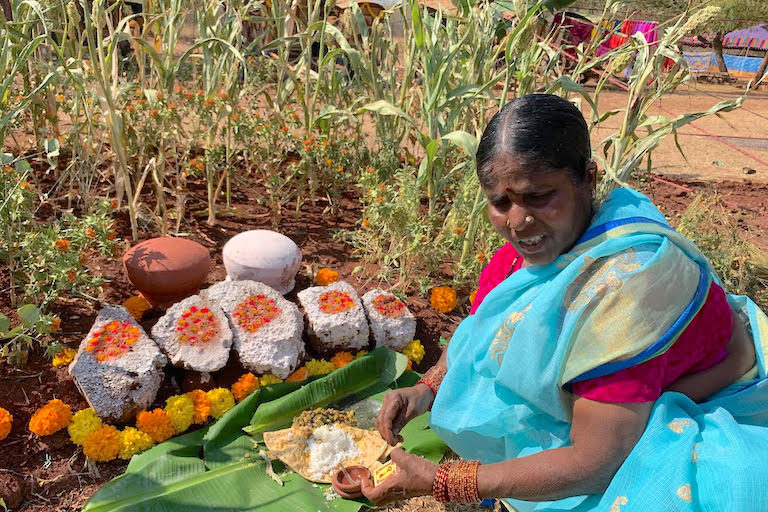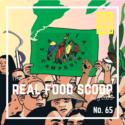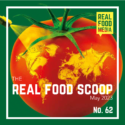by Anna Lappé, Mongabay
Just east of Birmingham in the U.K. sits the sixth-largest university in the country, Coventry University, home to 38,000 students and a relatively new center for the study of agroecology — a burgeoning field of social and environmental science.
Founded in 2014 and nestled on 9 hectares (22 acres) at Ryton Gardens, the Centre for Agroecology, Water and Resilience (CAWR) provides an academic home to 45 full-time research staff and more than 50 Ph.D. students, nearly half hailing from outside the U.K., including Africa, Asia and Latin America. From its inception, the center has taken a transdisciplinary approach, employing the knowledge and skills of social scientists, natural scientists and artists-in-residence. More than 50 master’s students and 42 agroecology practitioners are graduates of its program, and it’s recognized internationally for its work on alternative food networks and “agroecological urbanism” — the concept of bringing agroecology principles like diversity and mimicking natural ecosystems into urban food planning — and is now at the forefront of pushing agroecology and food sovereignty forward.
Following her feature for Mongabay about agroecology as a leading solution to climate change in response to the recent Intergovernmental Panel on Climate Change report calling for urgent action, author and sustainable food advocate Anna Lappé is interviewing leaders in the field of agroecology education, research and extension. She begins with Michel Pimbert, founder and director of the center, to better understand Coventry University’s work bringing agroecology to much wider attention. The interview was conducted by email and has been edited lightly for length and clarity.

Mongabay: Let’s start at the beginning. What’s the birth story of the center?
Michel Pimbert: In 2013, the university invited staff across the schools to pitch ideas for new areas of research. Much to my surprise, my proposal for a significant new center on agroecology and sustainable food systems was very well received! The university understood that hardly any research was going on in agroecology at the time, whether in the U.K., Europe, or beyond. Lucky for us, the vice chancellor and his team were quick to see that creating a new agroecology center would be a unique selling point for the university. This led to the birth of the Centre for Agroecology, Water and Resilience. Since then, we’ve received significant investments to recruit staff and Ph.D. researchers, attract international talent, and build a strong global research program on agroecology and sustainable food systems. Across all this work, and from the very beginning, we’ve emphasized the need to include peoples’ knowledge in ways of knowing and the co-creation of knowledge.
Mongabay: You’ve talked about the concept of “cognitive justice.” I had never heard that phrase before I heard you use it. It’s quite provocative. Can you share what you mean by it and how it relates to your approach to teaching, learning, and knowledge dissemination?
Michel Pimbert: The term comes from our philosophy of knowledge. Unlike many mainstream institutions, we reject the idea that academic knowledge is superior to the knowledge of Indigenous peoples and peasant farmers. This is what we mean by a commitment to “cognitive justice” — and I see it as key for agroecology, which aims to combine farmers’ knowledge with ecological science. But it also matters more generally for our work on decolonizing curriculum and transforming research for a just and sustainable society.
Mongabay: “Resilience” has become quite the buzzword, but it’s always been central to your work — it’s even in your name! How do you bring a study of resilience into your programs?
Michel Pimbert: When we focus on developing agroecological practices for resilience, we mean resilience to the climate crisis and to market volatility. We focus on how building farmer and citizen knowledge to improve agroforestry, intercropping and polycultures, evolutionary plant breeding, integrating livestock in agricultural systems as well as promoting shorter food webs to link producers and food eaters are all key to such multifaceted resilience. Another research strand is community self-organization. By that, we mean a focus on how — and under what conditions — communities can collectively mobilize their knowledge and agency to respond to crises like floods, droughts, and other natural/man-made disasters, and self-organize for managing alternative food networks and local governance.

Mongabay: Right. You often emphasize how agroecology is not just about what happens on the land but what happens in power structures, too. How does that show up in the CAWR’s research?
Michel Pimbert: Yes, exploring strategies for transforming governance — for agroecology, food sovereignty, and the right to food for all — is a key priority for the center. For that reason, research at the center also focuses on local to global policy choices that are needed to tackle threats to people and nature, and to promote agroecology and sustainable food and farming systems. We also look at institutional choices such as land tenure that can support large-scale shifts towards agroecology.
Mongabay: Can you share an example of a research project that embodies your center’s cross-disciplinary approach?
Michel Pimbert: Yes! I think the contributors from all around the world who used stories, poems, photos, and videos to create Everyday Experts: How people’s knowledge can transform the food system demonstrate well this transdisciplinary approach. It’s also a powerful showcase of how people’s knowledge can help transform the food system towards greater social and environmental justice.
Mongabay: You talk about the co-creation with movement partners for your research?
Michel Pimbert: Our partnerships grow out of conversations with social movements and peasant organizations. We are often asked to include them in funding bids or to provide research support for projects they have prioritized. One of the challenges is the typical donor approach, which does not allow open-ended, flexible, process-oriented projects of co-inquiry that social movements often require. Donors often have what I call a “log frame mentality” — one that is rigid and overemphasizes quantitative objectives.
Mongabay: In a recent Mongabay feature, I talked about how the latest IPCC report centers agroecology as a key climate solution. Are you excited by its new popularity?
Michel Pimbert: Yes, it’s exciting to see the greater acceptance and understanding of the potential of agroecology since the center was founded eight years ago. However, it’s important to stress that funding for agroecology remains pitifully small — the lion’s share of public funds continues to support industrial and “green revolution” agriculture. Agricultural policies and subsidies continue to support larger farmers and the use of agrochemicals that massively harm people and the land, and fuel runaway climate change. What’s more, I would caution that as agroecology becomes more popular, we have to resist the watering-down of ideas and cooptation; it’s important to continue to commit to an agroecology that transforms the dominant food regime rather than one that seeks to conform with it.
See more of Mongabay’s agroecology coverage here.

Mongabay: How does biodiversity intersect with teaching agroecology?
Michel Pimbert: Conserving and enhancing biodiversity — both domesticated and wild — is key for agroecology. Moving from uniformity to diversity on the farm and the wider landscape requires an emphasis on much higher levels of biodiversity. Take pest management, for instance: instead of relying on petroleum-based pesticides, agroecological solutions address on-farm pests by diversifying local ecology to enhance the abundance of natural enemies of pests and diseases. To reduce soil erosion and loss of water, these methods focus on planting diverse cover crops and terracing. To buffer against climate extremes, diversity-rich agroforestry creates micro climates, and on and on and on. Agroecological practices based on the use of greater biodiversity also enhance dietary diversity that is essential for improving health and combatting malnutrition.
Mongabay: How has the climate crisis impacted how you approach research?
Michel Pimbert: A focus on climate change was built into the center’s program from the start. The center’s climate scientists have been modeling changes to develop better prediction for droughts, floods, and forest fires in Africa, Europe and Asia. Agroecological approaches to climate adaptation are explored in Africa and Europe as well as Central America. We also do policy research aimed at exposing corporate greenwashing and the threats posed by nature-based solutions and net-zero plans that are now promoted by post-COP26 finance for climate change.
Mongabay: From your center’s research, what are you seeing about how agroecology can scale to meet global nutritional needs?
Michel Pimbert: Agroecological practices have been shown to increase production in the developing world. By harnessing more biodiversity on the farm and in food chains, agroecology can increase dietary diversity, something that is so badly needed today, including in wealthy societies hooked on junk food and highly processed foods. However, to be clear: Agroecology should not be seen as another technical fix for hunger and malnutrition. Agroecological production that enhances the availability of a diversity of foods needs to be part of a wider societal process of transformation that prioritizes equitable access to land and other means of production, fair access to — and distribution of — food, and supports people’s agency to claim and realize the right to food for all.
See related: From traditional practice to top climate solution, agroecology gets growing attention

Mongabay: It’s clear that what you’re calling for is massive transformation. From your vantage point, what are its greatest hurdles?
Michel Pimbert: In this moment, there are two starkly contrasting models of development, each seeking to radically transform food and farming. The first focuses on modernizing and sustaining capitalism through the promotion of what is being called the fourth Industrial Revolution (4IR). The 4IR relies on robots, gene editing, remote sensing, big data, drones, vertical farms, cell-cultured “meat,” digital technologies, and the “internet of things” to manage plants, animals, and the wider farming environment, as well as the entire agri-food chain. The second pathway emphasizes food sovereignty and agroecology.
Mongabay: Let me guess which pathway your center promotes.
Michel Pimbert: Clearly, food sovereignty and agroecology — and we are not alone: I’m inspired by countless programs around the world who share our vision. But the dominant discourse on modernity and progress, government policies, and funding priorities still favor the energy-intensive 4IR — and thus, frustratingly, continue to fuel the climate crisis, mass species extinction, and the economic genocide of farmers. It should come as no surprise to anyone that the financial and corporate actors who disproportionately benefit from the emerging 4IR are its biggest boosters and pose the biggest hurdles for a transformative agroecology based on diversity, decentralization, autonomy, and democracy.
Mongabay: It’s such a dark time in so many ways — from a persistent global pandemic to senseless wars and climate crisis-induced weather extremes — what inspires you amidst all this?
Michel Pimbert: Despite all the odds, I am inspired by the many people-led initiatives that are helping to reinvent food and farming for a more convivial, just, peaceful, and sustainable world.




